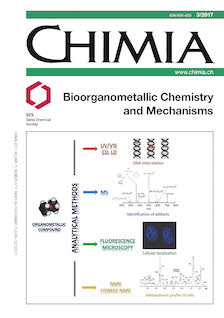Investigation of Non-covalent Interactions of Metal Complexes with DNA in Cell-free Systems
DOI:
https://doi.org/10.2533/chimia.2017.102Keywords:
Cd/ld spectroscopy, Dna, Fluorescence emission spectroscopy, Nmr spectroscopy, Uv/vis-spectroscopyAbstract
Non-covalent interactions of metallo compounds with DNA range from the simple, unspecific electrostatic binding of a positively charged metal complex to the sequence-selective recognition of DNA binding sites due to shape, size, symmetry and hydrogen bonding complementarity of a rationally designed system. Metal complexes that recognize and target specific DNA sequences or particular structures are of considerable interest as therapeutics, diagnostics or structural probes. To gain molecular level insight into DNA–metal complex interactions, binding studies are carried out in cell-free systems using isolated DNA or short oligonucleotides. For this, a powerful toolbox of complementary spectroscopic and biophysical techniques is available. This review focuses on the most frequently applied spectroscopic methods; UV/Vis, CD, LD, fluorescence emission and NMR spectroscopy and is aimed at giving the reader an overview of the qualitative and/or quantitative information that can be obtained. After a short introduction into DNA structures and non-covalent metal complex–DNA interactions, each spectroscopic method will be discussed. In the last section a few selected studies will be described as illustrative examples for the potential of the various spectroscopic methods.Downloads
Published
2017-03-29
Issue
Section
Scientific Articles
License
Copyright (c) 2017 Swiss Chemical Society

This work is licensed under a Creative Commons Attribution-NonCommercial 4.0 International License.
How to Cite
[1]
A. Erxleben, Chimia 2017, 71, 102, DOI: 10.2533/chimia.2017.102.







